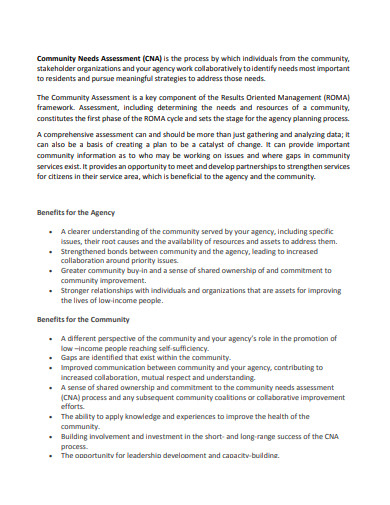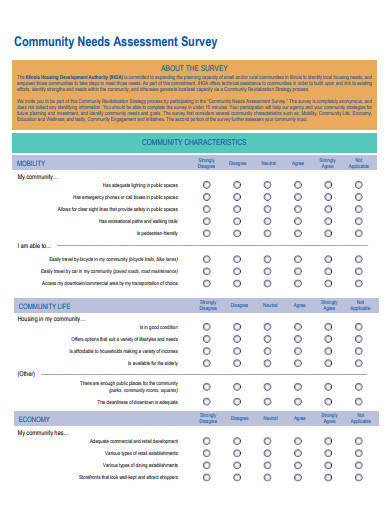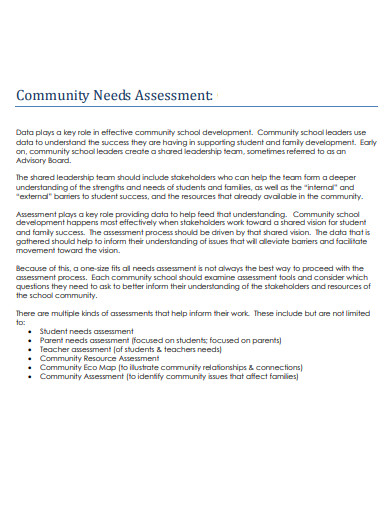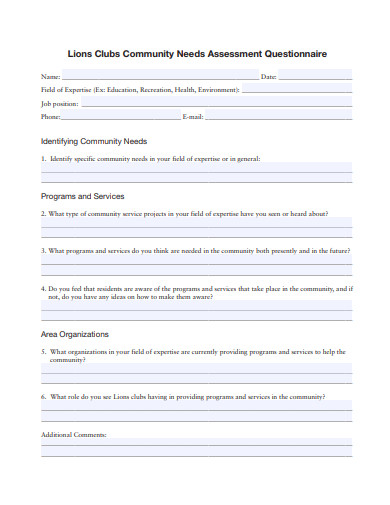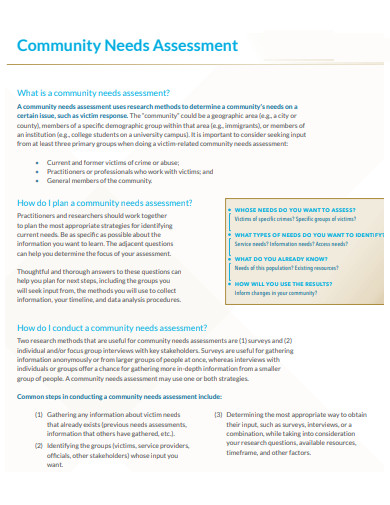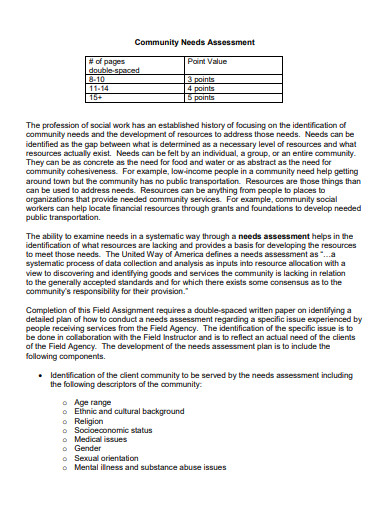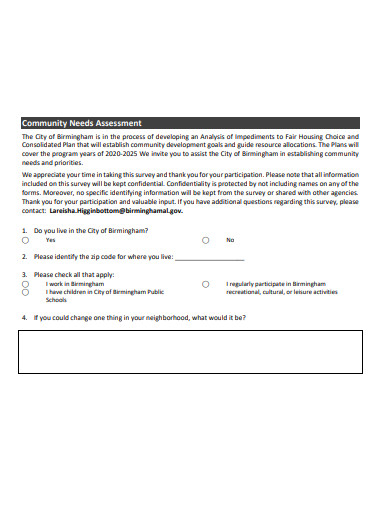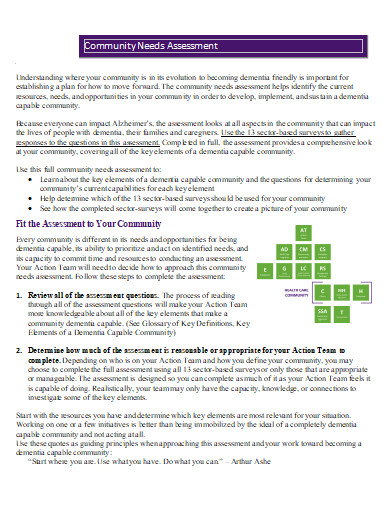10+ Community Needs Assessment Examples to Download
Handling and planning on running a huge community or an organization is never an easy task to begin with. Being a leader to a lot of people with different needs can also be a difficult task to do. Each person in the community may need something more than the other or may need less than the other as well. Not only is this a stressful yet fruitful task, it can also be quite difficult to keep up with. However, like any other problems, there are always keys or solutions to make them easier. Heads of communities, organizations or even companies no longer need to bear the problem of guessing or assuming which also has a lot of assessing risks when done that way, that this community needs this and that community needs that. All this can be done through a community needs assessment. What is this you ask? Check out the article below for more information, as well as checking the examples and downloading them for more.
What is a Community Needs Assessment?
A community needs assessment is a kind of assessment that assesses, evaluates and hands out the result of the needs of a certain group of people in an organization or in a community. This kind of assessment helps leaders or anyone assigned to communities to plan out and to understand the different needs of the people in their community. In addition to that, a community needs assessment report outlines the needs of each individual, finds a solution for the problem, identifies the severity of the need especially when it comes to the health of each individual. A community needs assessment is the first step to planning out a solution to the different types of needs and to assure that everyone in the community receives the kind of help or the kind of need that they are seeking. It also underlines, identifies, analyzes, assesses and evaluates the main or the general health problem for the community. As well as to find a way to meet their needs either through hospitals, medications or a better living situation for most.
The purpose of doing a community needs assessment is to be able to know the needs of the people in your community. To find out if basic needs like health, a home, food and water are available for those who may need it. Doing the assessment examples not only helps you find out who may need something, but it also helps you figure out what type of needs can be done and what type of needs are useful for all the people in the community. Not only that, the assessment is also useful in outlining your plans for a better community.
Examples of Community Needs Assessment:
Here is a Example List of Community Needs Assessment:
Health Care Access Assessment
- Surveys to determine gaps in health care services
- Analysis of local health care utilization and barriers
- Mapping of health care facilities versus population distribution
Educational Resources Evaluation
- Studies on school performance and resource allocation
- Surveys of parental and student satisfaction with local schools
- Assessments of adult literacy and continuing education needs
Economic Development Analysis
- Labor market studies to identify employment trends and gaps
- Surveys of local businesses to understand economic challenges
- Analysis of job training and placement program effectiveness
Housing Availability and Affordability Study
- Inventories of current housing stock and conditions
- Surveys on housing affordability and homelessness rates
- Analysis of demographic trends and future housing needs
Food Security Survey
- Research on the prevalence of food deserts
- Surveys of community security access to nutritious food options
- Analysis of the use and impact of food assistance programs
Public Safety and Crime Statistics Review
- Compilation and analysis of local crime data
- Community perception surveys on safety and law enforcement
- Evaluation of community-based crime prevention programs
Environmental Quality Study
- Assessments of local environmental hazards and pollution levels
- Community surveys on environmental concerns and awareness
- Analysis of green space availability and usage
Transportation Needs Survey
- Studies on public transit accessibility and reliability
- Surveys of community satisfaction with transportation options
- Analysis of transportation barriers for special populations
Child and Family Services Assessment
- Evaluation of childcare service availability and quality
- Surveys of family assessment support services and gaps
- Analysis of child welfare and protection services
Social Services Utilization and Gap Analysis
- Mapping of social service provision versus demand
- Surveys on the awareness and accessibility of social programs
- Analysis of service gaps for vulnerable populations
Community Engagement and Cultural Activities Survey
- Assessments of participation in community events and civic groups
- Surveys on the availability and accessibility of cultural activities
- Analysis of barriers to community engagement
Digital Divide and Technology Access Study
- Surveys of internet and computer access in homes and schools
- Analysis of the impact of technology on education and employment
- Evaluation of community health programs aimed at increasing digital literacy
Example List of Community Needs:
Here is a Example List of Community Needs:
Community Needs: A Comprehensive List
Access to Quality Education:
- Schools with adequate resources
- Adult education programs
- Vocational training centers
- Libraries with updated materials and internet access
Healthcare Services:
- Affordable healthcare clinics
- Mental health needs assessment support services
- Substance abuse treatment programs
- Health education and preventive care
Economic Development:
- Job creation initiatives
- Support for local businesses
- Workforce development assessment programs
- Access to microloans and financial literacy training
Safe and Affordable Housing:
- Well-maintained public housing
- Homelessness prevention programs
- Support services for renters and homeowners
- Emergency shelters
Food Security:
- Food banks and pantries
- Nutritional assistance programs
- Community gardens
- School meal programs
Public Safety:
- Effective law enforcement
- Community policing initiatives
- Fire and emergency services
- Disaster preparedness resources
Environmental Health:
- Clean air and water initiatives
- Recycling and waste management programs
- Green spaces and public parks
- Environmental education
Transportation:
- Reliable public transit systems
- Safe roads and pedestrian walkways
- Accessible transportation for the disabled
- Affordable community ride programs
Childcare and Support for Families:
- Affordable childcare services
- Parenting classes
- Support groups for single parents
- Youth mentoring programs
Social Inclusion:
- Programs for the elderly
- Support for people with disabilities
- Multicultural and interfaith initiatives
- LGBTQ+ support services
Community Engagement:
- Public forums and town halls
- Volunteer and civic engagement opportunities
- Community centers
- Local arts and cultural events
Access to Technology:
- Public Wi-Fi zones
- Digital literacy training
- Access to computers and broadband services
- Support for technology in schools
Infrastructure:
- Well-maintained public facilities
- Up-to-date utility systems
- Flood defenses and water management
- Street lighting and signage
Building a community that addresses these needs requires collaboration between local government, private organizational assessment, and the community members themselves. It’s a dynamic process that adapts to the evolving challenges and opportunities within the community.
10+ Community Needs Assessment Examples
1. Community Needs Assessment Template
2. Community Needs Assessment Survey Outline
3. Community Needs Assessment Example
4. Community Needs Assessment Questionnaire
5. Student Community Needs Assessment in PDF
Types of Community Needs Assessments:
Here is a Types of Community Needs Assessments:
Asset-Based Assessments:
Focuses on identifying and utilizing existing community strengths and resources to meet community needs.
Deficit-Based Assessments:
Centers on identifying and addressing deficiencies or gaps in community services and resources.
Comparative Needs Assessments:
Compares the needs of different communities or subgroups to allocate resources effectively and equitably.
Participatory Assessments:
Engages community members directly in the process to ensure that the assessment reflects their perspectives and priorities.
Sector-Specific Assessments:
Targets specific sectors such as health, education, or housing, to gain a detailed understanding of needs within a particular domain.
Integrated Needs Assessments:
Combines various sectors and considers the interplay between them, providing a comprehensive overview of community needs.
Rapid Appraisal Methods:
Quick, cost-effective assessments that use existing data and community input to identify key issues without extensive surveys.
Strategic Needs Assessments:
Aligns with the strategic planning processes of organizations or communities to ensure that the assessment contributes to long-term goals.
Quality-of-Life Assessments:
Evaluates a broad range of factors that affect the well-being and quality of life of community members.
Benchmarking Assessments:
Uses a set of standards or benchmarks to evaluate community services and outcomes against best practices or other communities. You may also see housing needs assessment.
6. Standard Community Needs Assessment
7. Community Needs Survey Assessment Format
8. Printable Community Needs Assessment Form
9. Basic Community Analysis Needs Assessment
10. Community Needs Assessment Social Work
11. Community Health Needs Assessment
How to do a Community Needs Assessment?
Step 1: Define the Scope and Purpose
- Clarify the objectives of the assessment.
- Determine the geographic boundaries and population groups to be studied.
Step 2: Assemble a Diverse Team
- Gather a team with varied expertise and community representation.
- Include stakeholders such as local government, non-profits, and community leaders.
Step 3: Collect Data
- Use both primary data (surveys, interviews, focus groups) and secondary data (existing reports, statistics).
- Ensure data collection methods are culturally appropriate and accessible.
Step 4: Analyze the Data
- Identify patterns, gaps, and trends in the community’s needs.
- Use statistical methods and qualitative analysis to interpret the data.
Step 5: Engage the Community
- Involve community members in the assessment process for transparency and inclusivity.
- Use town hall meetings, forums, or social media to gather community input.
Step 6: Prioritize Needs
- Based on the data, determine which needs are most urgent or have the greatest impact.
- Consider the community’s resources and capacity to address these needs.
Step 7: Develop an Action Plan
- Create a strategic plan outlining how to address the prioritized needs.
- Set goals, objectives, and timelines for implementing solutions.
Step 8: Report Findings
- Share the results of the assessment with the community and stakeholders.
- Use clear, non-technical language and visual aids to present the findings.
Step 9: Implement the Plan
- Mobilize resources and collaborate with partners to take action.
- Begin with achievable steps to build momentum and demonstrate progress.
Step 10: Evaluate and Adjust
- Monitor the outcomes of the implemented strategies.
- Adjust the action plan based on what is or isn’t working.
Step 11: Document and Reflect
- Keep detailed records of the process and outcomes.
- Reflect on what was learned and how it can inform future assessments.
How to Write a Community Needs Assessment?
Now that we know the purpose of having to write a community needs assessment examples, the next thing to know about is how to write one. Every community needs an assessment as unique as the one who wrote it. As no two communities may have the same needs or the same amount of needs as the other. Knowing how to write a community needs assessment planning is essential, and the following tips will show you how.
1. Begin by Gathering Data
When doing any kind of assessment or a specific kind of assessment like a comprehensive needs assessment, it is always good to do your research. Gather as much information as you can by conducting surveys around the community. A general survey can still be part of gathering the data you need to begin the assessment. Remember to use questions in your survey that would help you when doing the assessment. As well as these questions must be related to the purpose and reason for starting an assessment with questionnaire.
2. Analyze, Assess, Evaluate
Once you have gathered all the data needed, it is time to analyze, assess and evaluate. Analyze from the data gathered which of the common needs are being voted or being demanded the most. Assess how many of these people may have asked for this kind of need, and evaluate on what your next step should be.
3. Identifying by Groups
Given the fact that there are a lot of people in the community, the best way to minimize the problem while doing the assessment is to put them into groups. Each group has a title and a solution of its own. The groups could be by race, by age or by their needs.
4. List Your Solutions
After you have done the assessment, it is time to list down your solutions. Depending on how many problems have been assessed would also matter at how many solutions should be placed. Give each solution a time frame to make it work.
5. Start Your Action Plan
Your action plans should be the realistic results of the assessment you have done. These plans must also cater to the complete needs of your community.
FAQs
What is a Community Needs Assessment?
A community needs assessment is a kind of assessment report done to know the needs of the people in the community. A kind of assessment that outlines the problems the community may be facing.
What does a Needs Assessment include?
A needs assessment includes identifying and prioritizing gaps between current conditions and desired outcomes, gathering data through surveys, interviews, and focus groups, analyzing the data to understand the issues, and developing a strategic plan to address the needs with actionable steps, resources required, and stakeholders involved.
What is the purpose of doing this kind of Assessment?
To check the issues and to address the needs of every person as much as possible. It also outlines the series of solutions for each person or group of people who may benefit from it.
How do you identify a needs assessment?
To identify a needs assessment, recognize a gap between the current state and desired outcomes within a community or organization. Look for indicators such as performance shortfalls, community concerns, or changes in demographics that suggest a need for improved services, resources, or interventions to meet those unaddressed or emerging needs.
What is the first phase of community needs assessment?
The first phase of a community needs assessment is the planning stage. It involves defining the scope and objectives, assembling a diverse team, identifying data sources, and determining the methods for data collection. This foundational phase sets the direction for the entire assessment process.
What is the purpose of a Community Health Needs Assessment?
The purpose of a community health needs assessment is to identify and evaluate health-related issues within a community, understand the population’s health status and resources, prioritize health challenges, and develop strategies to address disparities, improve public health, and allocate resources effectively to where they are most needed.
What to avoid when doing the Assessment?
Don’t be too biased. Avoid solutions that may be too impossible to do. The assessment is supposed to help you find a way to solve at least a few if not some of the issues in the community. Your solutions should also benefit the people in general and not just one or two people.
It is not easy to handle a community with different needs. Let alone having to find solutions for the problems as well as meeting the needs of others. It is also not as easy as it sounds to find a way to manage everyone’s needs and give it in equal portions. Doing the community needs assessment for social service not only helps you understand and know what they may need but it also lets you know what they really need.



